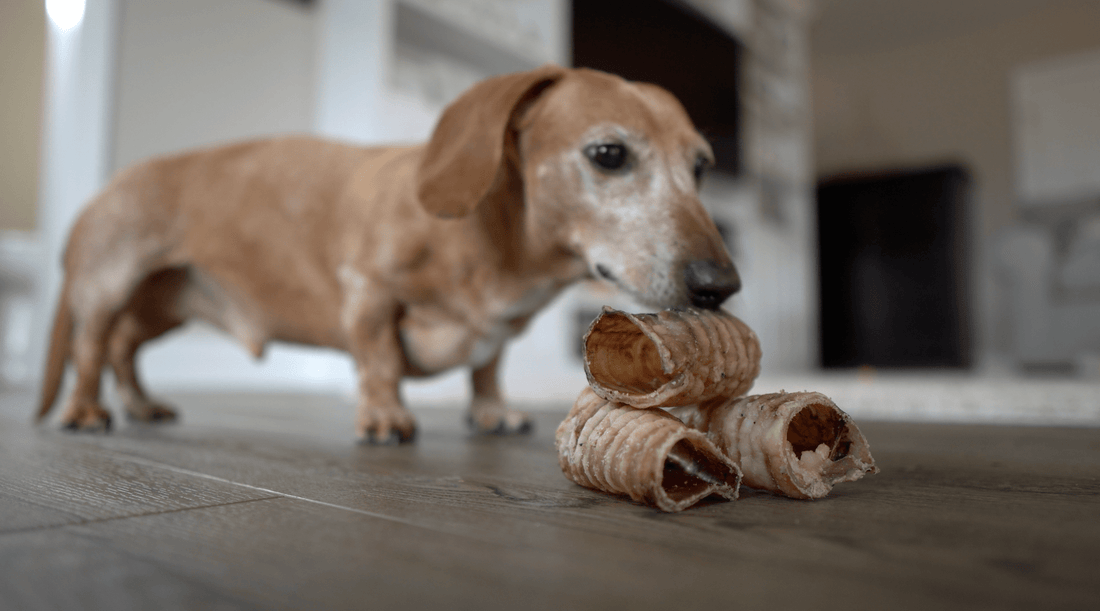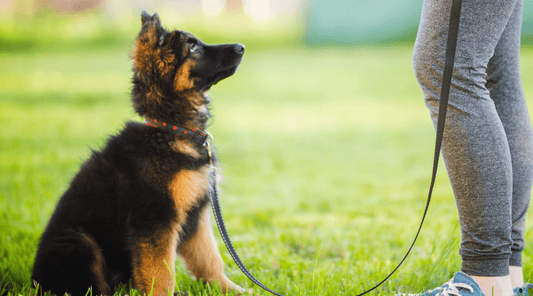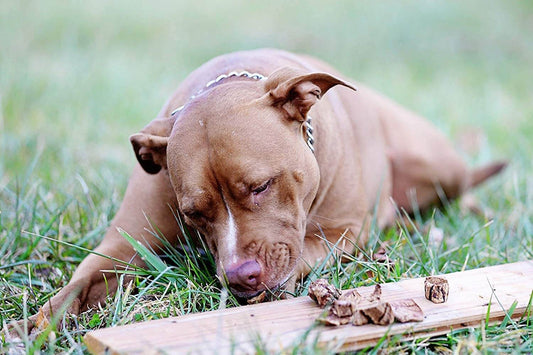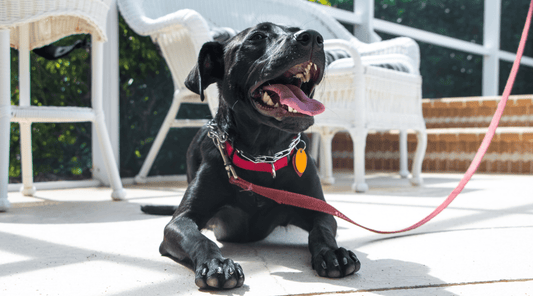
Dog Joint Health: Is Bruno's Slow Stretch a Sign of Something?
Dawn Miller Apr 02, 20255 Minute ReadOne morning, I noticed Bruno didn’t want to get off the couch.
At first, I thought he was just being lazy. It was raining, and Bruno has strong “cozy homebody” energy when the weather’s bad. But then I noticed the hesitation in his back legs, that little stiff movement dogs make when they’re not quite comfortable.
Pixie, meanwhile, was doing zoomies across the living room, oblivious to his plight.
It's a simple fact of life. Some dog breeds (e.g., labs like Bruno) are more likely to develop dog joint health issues as they age. It's close to an inevitability if they get to live a long, full life like Bruno.
But while some stiffness is unavoidable, dog joint pain relief can support comfort and mobility as he ages.
Middle-Aged Dog? Dog Joint Health Deserves a Spot on Your Radar
It's never too early to pay attention to dog joint mobility.
Dog joints work hard—whether they’re running, jumping, playing tug, or just climbing onto the couch. It all takes a toll over time—especially for:
- Large breeds
- Senior dogs
- Super active dogs
- Dogs who’ve had injuries in the past
Over the years, the cartilage starts breaking down and repairing more slowly. You might even notice early signs of arthritis in dogs by mid-age. Bruno's not an elderly pup. He's still got some years of hiking and swimming at the lake in him. But even his joints are starting to protest after a long period of rest.
Here's the good news! You can start supporting joint health early to improve joint comfort and mobility—primarily by enhancing canine nutrition.
Early Signs of Arthritis in Dogs
Dogs treat hiding pain like a second job. They might yelp if someone plays a little rough. But most of the time, they just try to walk it off. So, as a dog mom, I look for certain signs:
- Hesitating before climbing stairs or jumping into the car
- Limping or stiffness, especially after naps. Prolonged sitting is as bad for dogs as it is for you and me.
- Slowing down on walks
- Licking or chewing at joints. Remember: dogs use the mouth like a hand, so what you're seeing is the massaging of a sore joint.
- Loss of interest in play
- Trouble getting comfortable when lying down
Any of that sound familiar? It only gets worse unless you take action. So, let's talk solutions.
Daily Habits That Support Joint Health
1. Keep Your Dog Moving (But Don’t Overdo It)
Joint pain is a funny thing. You might think moving less reduces it. But that can be counterproductive. Dog joints stay lubricated and healthy through regular movement. So, low-impact exercise is key.
Think daily walks, swimming, or a gentle game of fetch. More vigorous exercise is okay sometimes if your dog seems to enjoy it, not if it leaves them in pain, unwilling to get off the couch like Bruno the other morning.
Struggling to keep your dog active? Consider adding a 5 minute positive reinforcement training session to your daily routine. Experts believe that dogs can learn around 120 distinct commands. Whether you're teaching them games you can play together or how to be more cooperative on a walk, dog training is the answer.
Our 7-Day Dog Training Challenge isn’t just about commands—it’s also packed with tips for whole-dog wellness. Because healthy joints = better focus, more fun, and fewer skipped walks.
👉 Sign up here to join the next challenge.
I’ve got a neighbor who sets up mini agility stations in her backyard—her senior Border Collie loves weaving through the cones (with plenty of breaks and healthy dog treats in between). Dog training makes activities like these possible.
2. Maintain a Healthy Weight
Bodies are very resilient. But weight is multiplied many times over during activities like running and jumping.
Extra pounds = extra stress on joints. Keep your dog at a healthy weight by watching their portions, keeping them active, and sticking to nutrient-rich, low-calorie treats (like single-ingredient lung bites).
3. Add Joint-Supporting Foods
Marrow bones, cartilage, organ meat, and supplements can give your dog’s joints the nutrients they need to stay strong. Even puppies benefit. They're growing fast and can build stronger tissues with the right nutrition.
Here's what they need:
- Glucosamine + Chondroitin: Help rebuild cartilage and reduce pain
- Omega-3s (grass fed beef): Anti-inflammatory and heart-healthy. Grass-fed beef has 2.5X more omega-3 than that of conventional herds.
- Collagen: A structural protein and the key building block of cartilage and connective tissue
- Antioxidants: Help protect joints from damage over time
- Hyaluronic acid: Supports joint lubrication, reducing breakdown rate
These nutrients aren't super common in an all-kibble diet. In fact, omega-3 and antioxidants are almost non-existent because they don't survive high heat.
The Best Supplements for Dog Joint Health Start in the Kitchen
Here’s the part where we talk food (Bruno’s favorite topic). But remember, we can't stop all joint discomfort in aging dogs, especially in larger breeds. My goal is always to reduce discomfort and maintain mobility. We can and should do this for our dogs, who deserve the best we can give.
It's important to supplement an all-kibble diet with dog joint supplements. And I'm a big fan of supplementing with real, whole foods rather than pills when I can.
Here's a look at Bruno's diet.
- Single-ingredient dog treats. I use grass fed beef lung dog treats for dog training. These organ meats are rich in collagen, omega-3, and other key nutrients.
- Roasted beef marrow dog bones around 2X a week. Also, rich in hard-to-get dog joint health nutrients.
- Beef trachea at least once a week. Trachea is a connective tissue, so it's loaded with glucosamine, chondroitin, MSM, and hyaluronic acid.
- Anti-oxidant-rich, anti-inflammatory foods like pumpkin, butternut squash, blueberries, apples, carrots, and fresh green beans. Bruno loves the local farmer's market as much as I do.
Here's what I do — and you can try it. I get a meaty marrow bone.
After the marrow is gone, I refill it with these ingredients and sometimes natural peanut butter or plain yogurt (Greek-style is thicker, so it works best). You can fill trachea tubes for a more substantial dog treat.
Note: Never give your dog dinner bones. These are too soft and can cause blockages. Always buy dog bones from a reliable vendor like K9 Connoisseur. They expertly roast each grass-fed dog bone using a slow and low heat cooking process.
The Role of Dog Bones in Dog Health
So let’s talk bones.
When we give dogs long-lasting bones, we’re not just keeping them busy or supporting joint health. Dog bones are actually a vital part of dog life and dog health—in a way that rubber chew toys and unhealthy dog treats just don't suffice.
Dogs chew on dog bones to:
- Entertain themselves
- Alleviate boredom
- Reduce anxiety
- Maintain healthy teeth and gums
Dogs don't know about the nutrition in marrow bones. All they know is that dog bones taste good and that chewing on them feels good. I support my dogs' mental and physical health by giving them the single-ingredient dog bones they deserve.
Available On:


Disclosure: This article may contain affiliate links, which means we may earn a small commission if you make a purchase through these links—at no extra cost to you. We only recommend products we trust and believe will benefit you and your K9.



